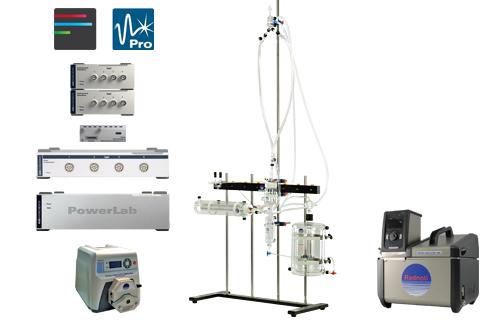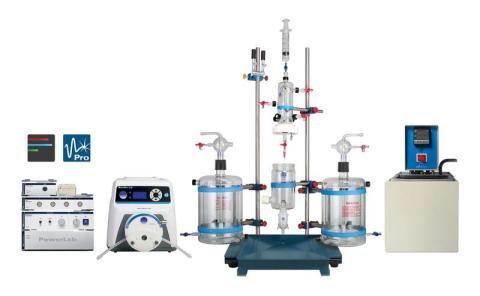Constant flow vs. constant pressure perfusion - What’s the difference?
A key point to consider when designing a Langendorff isolated heart experiment is whether to choose a constant flow or constant perfusion pressure setup. Ultimately, the decision will depend on the biological question you are trying to answer, as both modes of perfusate delivery have their advantages and disadvantages depending on the experimental set-up.
Constant perfusion flow mode (stable flow)
Advantages: In a constant flow set-up, the flow of the perfusate through the coronary vasculature is maintained at a constant rate (using a peristaltic pump), allowing the user to monitor any changes in coronary pressure during the course of the experiment.
In this configuration, changes in left ventricular pressure would be measured by inserting a balloon catheter into the left ventricle. A constant flow setup is particularly useful for low-flow models of ischemia and pharmacological studies, such as looking at the effect of vasoactive substances on coronary vasomotor tone; a parameter which can be derived from coronary pressure1.
Limitations: One of the main disadvantages of constant flow perfusion is that it overrides any autoregulatory mechanisms of the heart.
This means the amount of perfusate delivered to the heart is not automatically altered in response to changes in heart rate or work, or when regional ischemia occurs. For the latter, the same volume of perfusate would be forced through the compromised perfusion bed, which can lead to changes in flow per gram of tissue, as well as potentially damaging the coronary vasculature1,2.
Constant perfusion pressure mode (stable pressure)
As the name implies, in a constant pressure setup, the perfusion pressure is maintained at a constant rate, allowing the user to monitor any changes in flow over the course of an experiment.
Depending on the perfusion apparatus, constant pressure perfusion is achieved by either 1) using the height of the bubble trap / perfusion line to apply a constant hydrostatic perfusion pressure OR, 2) measuring the perfusion pressure and adjusting the flow rate to compensate for pressure changes in real-time.

Our Langendorff Constant Pressure Foundation System (options available for both mice and rats).
Advantages: In a constant perfusion pressure model, the heart maintains its ability to autoregulate coronary vascular tone and alter the perfusion flow to match the demands of the heart. This allows the experimenter to maintain a constant, steady perfusion pressure, even during coronary dilation or contraction.
This is particularly useful for studying pharmacological interventions or ischemia-reperfusion injury when perfusion to part of the vascular bed is restricted (as mentioned above).
Limitations: By monitoring variations in flow rate you can indirectly measure changes in vasculature resistance. However, as coronary flows are inherently low under constant perfusion pressures, it can be difficult to accurately assess vascular reactivity using this setup1. It’s also important to note that constant pressure protocols are not ideal when circulating volumes are small e.g. with whole-blood perfusion.
Our Solutions
We offer a range of solutions for both constant flow and constant perfusion pressure Langendorff setups. Our Radnoti Langendorff Foundation Systems can be customized for either constant pressure or flow for perfusing both mice and rat hearts. These systems center around apparatuses that are made from high-quality, crystalline glassware and include PowerLab data acquisition hardware, LabChart data analysis software. Further tailored cardiac measurements can be made by additionally purchasing from a range of compatible isolated heart kits and accessories. See here for more information about our Radnoti Langendorff Systems.
Our PowerLab C Rodent Langendorff Foundation System is also a great option for those who are wanting a high-quality, modular, yet compact Langendorff apparatus, which provides flexibility for configuring various isolated rodent heart experimental solutions. The STH Pump Controller uses the perfusion pressure to control the Peristaltic Pump’s speed, allowing the system to operate easily in constant perfusion pressure or perfusion flow. Additionally, the system is also supplied with LabChart Lightning software, flexible PowerLab C data acquisition, and hardware for measuring perfusion pressure and temperature. See here for a brief overview of the PowerLab C Rodent Langendorff Foundation System and its components.

Our PowerLab C Rodent Langendorff Foundation System.
Read more:
Langendorff vs Working Heart Perfusion – What’s the difference?
An introduction to the isolated Langendorff heart technique (free on-demand webinar)
Best practices and key considerations when for setting-up an isolated Langendorff heart preparation
References:
1. Liao, R., Podesser, B. K., & Lim, C. C. (2012). The continuing evolution of the Langendorff and ejecting murine heart: new advances in cardiac phenotyping. American journal of physiology. Heart and circulatory physiology, 303(2), H156–H167. doi:10.1152/ajpheart.00333.2012
2. Sutherland F.J., Hearse, D.J. (2000). The isolated blood and perfusion fluid perfused heart. Pharmacological Research, 41(6), 613-627. doi.10.1006/phrs.1999.0653
